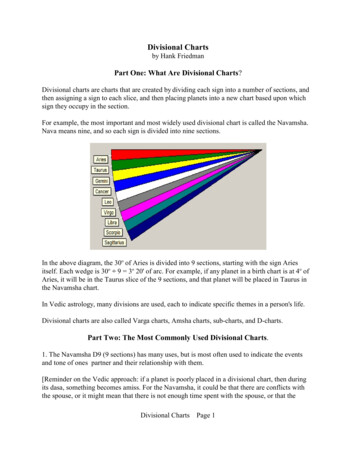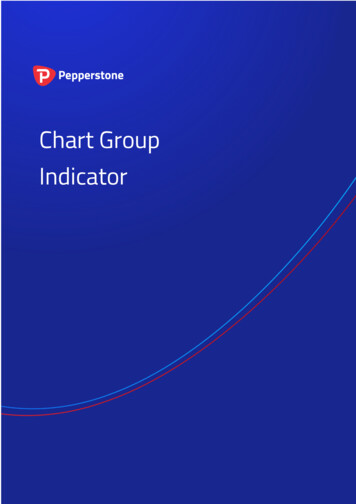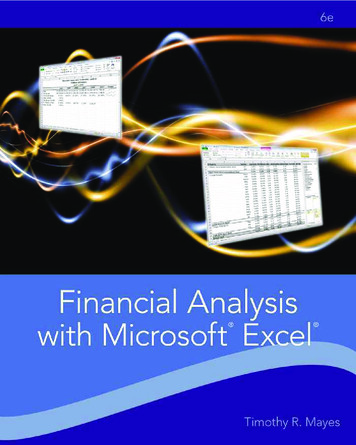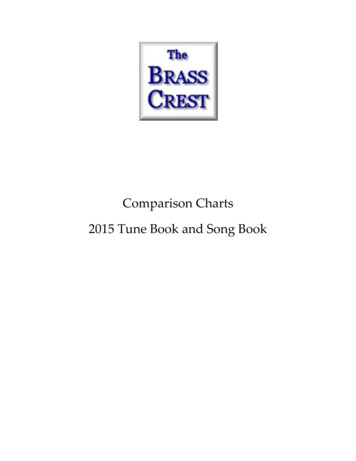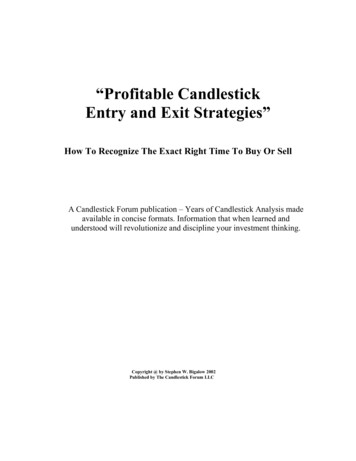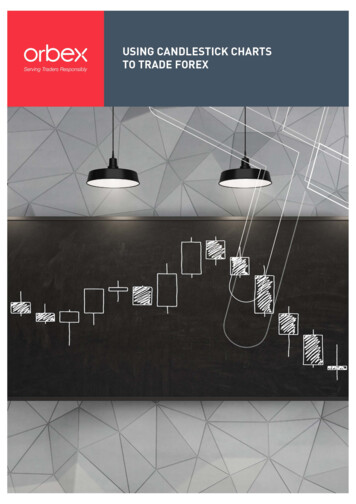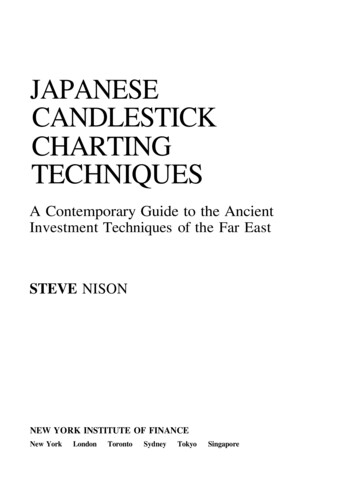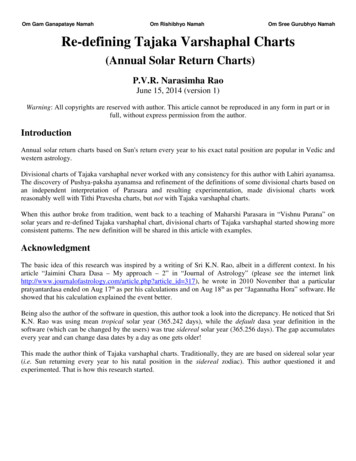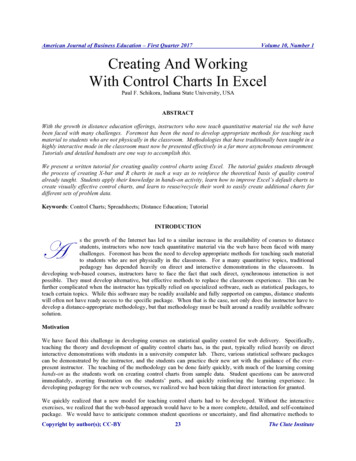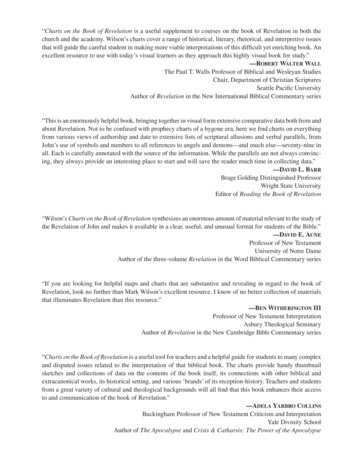
Transcription
“Charts on the Book of Revelation is a useful supplement to courses on the book of Revelation in both thechurch and the academy. Wilson’s charts cover a range of historical, literary, rhetorical, and interpretive issuesthat will guide the careful student in making more viable interpretations of this difficult yet enriching book. Anexcellent resource to use with today’s visual learners as they approach this highly visual book for study.”—Robert Walter WallThe Paul T. Walls Professor of Biblical and Wesleyan StudiesChair, Department of Christian ScripturesSeattle Pacific UniversityAuthor of Revelation in the New International Biblical Commentary series“This is an enormously helpful book, bringing together in visual form extensive comparative data both from andabout Revelation. Not to be confused with prophecy charts of a bygone era, here we find charts on everythingfrom various views of authorship and date to extensive lists of scriptural allusions and verbal parallels, fromJohn’s use of symbols and numbers to all references to angels and demons—and much else—seventy-nine inall. Each is carefully annotated with the source of the information. While the parallels are not always convincing, they always provide an interesting place to start and will save the reader much time in collecting data.”—David L. BarrBrage Golding Distinguished ProfessorWright State UniversityEditor of Reading the Book of Revelation“Wilson’s Charts on the Book of Revelation synthesizes an enormous amount of material relevant to the study ofthe Revelation of John and makes it available in a clear, useful, and unusual format for students of the Bible.”—David E. AuneProfessor of New TestamentUniversity of Notre DameAuthor of the three-volume Revelation in the Word Biblical Commentary series“If you are looking for helpful maps and charts that are substantive and revealing in regard to the book ofRevelation, look no further than Mark Wilson’s excellent resource. I know of no better collection of materialsthat illuminates Revelation than this resource.”—Ben Witherington IIIProfessor of New Testament InterpretationAsbury Theological SeminaryAuthor of Revelation in the New Cambridge Bible Commentary series“Charts on the Book of Revelation is a useful tool for teachers and a helpful guide for students to many complexand disputed issues related to the interpretation of that biblical book. The charts provide handy thumbnailsketches and collections of data on the contents of the book itself, its connections with other biblical andextracanonical works, its historical setting, and various ‘brands’ of its reception-history. Teachers and studentsfrom a great variety of cultural and theological backgrounds will all find that this book enhances their accessto and communication of the book of Revelation.”—Adela Yarbro CollinsBuckingham Professor of New Testament Criticism and InterpretationYale Divinity SchoolAuthor of The Apocalypse and Crisis & Catharsis: The Power of the Apocalypse
“More than any book in the Bible, Revelation needs to be visualized to be understood. Charts on the Book ofRevelation is a major step forward in doing just that. Every pastor and Bible teacher will benefit from usingthese charts in their study and as overheads when teaching and preaching through the book.”—Grant R. OsborneProfessor of New TestamentTrinity Evangelical Divinity SchoolAuthor of Revelation in the Baker Exegetical Commentary on the New Testament series“This is a novel idea and an inspired one. These charts will be invaluable to anyone studying the book ofRevelation in detail.”—Richard BauckhamProfessor of New Testament Studies and Bishop Wardlaw ProfessorUniversity of St. AndrewsAuthor of The Theology of the Book of Revelation
Charts on theLiterary, Historical,and Theological
kregelCharts of the Bibleand TheologyCharts on theLiterary, Historical, andTheological PerspectivesMark Wilson
Charts on the Book of Revelation: Literary, Historical, andTheological Perspectives 2007 by Mark WilsonMaps Tim Dowley, Three’s Company. Used by permission.Published by Kregel Publications, a division of Kregel, Inc.,P.O. Box 2607, Grand Rapids, MI 49501.All rights reserved. No part of this book may be reproduced,stored in a retrieval system, or transmitted in any form or byany means—electronic, mechanical, photocopy, recording, orotherwise—without written permission of the publisher, exceptfor classroom use or brief quotations in printed reviews.Scripture taken from the Holy Bible, New International Version .Copyright 1973, 1978, 1984 by International Bible Society.Used by permission of Zondervan. All rights reserved.Scripture quotations marked nrsv are from the New RevisedStandard Version Bible, copyright 1989, by the Division ofChristian Education of the National Council of the Churchesof Christ in the U.S.A., and are used by permission. All rightsreserved.BWHEBB, BWHEBL, BWTRANSH [Hebrew]; BWGRKL,BWGRKN, and BWGRKI [Greek] Postscript Type 1 andTrueTypeT fonts Copyright 1994–2006 BibleWorks, LLC.All rights reserved. These biblical Greek and Hebrew fonts areused with permission and are from BibleWorks, software forBiblical exegesis and research.ISBN 978-0-8254-3939-1Printed in the United States of America07 08 09 10 11 / 5 4 3 2 1
ContentsPreface . . . . . . . . . . . . . . . . . . . . . . . . . . . . . . . . . . . . . . . . . . . . . . . . . . . . . . . . . . . . . . . . . . . . . . . . . . 9Abbreviations . . . . . . . . . . . . . . . . . . . . . . . . . . . . . . . . . . . . . . . . . . . . . . . . . . . . . . . . . . . . . . . . . . . . .37.38.39.40.41.42.Authorship of Revelation . . . . . . . . . . . . . . . . . . . . . . . . . . . . . . . . . . . . . . . . . . . . . . . . . . . . . . . . . . 13Date of Revelation . . . . . . . . . . . . . . . . . . . . . . . . . . . . . . . . . . . . . . . . . . . . . . . . . . . . . . . . . . . . . . . . 14Roman Empire in the Late First Century a.d. . . . . . . . . . . . . . . . . . . . . . . . . . . . . . . . . . . . . . . . . . 15Time Line of the First-Century Church in Asia . . . . . . . . . . . . . . . . . . . . . . . . . . . . . . . . . . . . . . . . 17Jewish and Christian Apocalypses . . . . . . . . . . . . . . . . . . . . . . . . . . . . . . . . . . . . . . . . . . . . . . . . . . 19Literary Genres of Revelation . . . . . . . . . . . . . . . . . . . . . . . . . . . . . . . . . . . . . . . . . . . . . . . . . . . . . . . 20Chapter and Verse Counts with Text Set as Poetry . . . . . . . . . . . . . . . . . . . . . . . . . . . . . . . . . . . . . 21Words Occurring Only in Revelation (Hapax Legomena) . . . . . . . . . . . . . . . . . . . . . . . . . . . . . . . 22Allusions and Verbal Parallels in the Old Testament and Extrabiblical Literature . . . . . . . . . . . 25Structure of Revelation . . . . . . . . . . . . . . . . . . . . . . . . . . . . . . . . . . . . . . . . . . . . . . . . . . . . . . . . . . . . 31Identification of Christ with God in Revelation . . . . . . . . . . . . . . . . . . . . . . . . . . . . . . . . . . . . . . . . 32Divine Names in Revelation . . . . . . . . . . . . . . . . . . . . . . . . . . . . . . . . . . . . . . . . . . . . . . . . . . . . . . . . 33Names for Believers in Revelation . . . . . . . . . . . . . . . . . . . . . . . . . . . . . . . . . . . . . . . . . . . . . . . . . . . 35Apocalyptic Themes in Revelation, the Synoptic Gospels, and Pauline Epistles . . . . . . . . . . . . . 36Thematic Parallels Between Revelation and John . . . . . . . . . . . . . . . . . . . . . . . . . . . . . . . . . . . . . . 38Thematic Parallels Among Revelation, Jude, and 2 Peter . . . . . . . . . . . . . . . . . . . . . . . . . . . . . . . . 40Thematic Parallels Between Revelation and 4 Ezra . . . . . . . . . . . . . . . . . . . . . . . . . . . . . . . . . . . . . 41Theme of Victory in Revelation . . . . . . . . . . . . . . . . . . . . . . . . . . . . . . . . . . . . . . . . . . . . . . . . . . . . . 42Theories of Interpretation of Revelation . . . . . . . . . . . . . . . . . . . . . . . . . . . . . . . . . . . . . . . . . . . . . . 43Five Senses in Revelation . . . . . . . . . . . . . . . . . . . . . . . . . . . . . . . . . . . . . . . . . . . . . . . . . . . . . . . . . . 44Minerals, Gems, and Other Commodities in Revelation . . . . . . . . . . . . . . . . . . . . . . . . . . . . . . . . 45Symbols Interpreted in Revelation . . . . . . . . . . . . . . . . . . . . . . . . . . . . . . . . . . . . . . . . . . . . . . . . . . 46Use of Numbers in Revelation . . . . . . . . . . . . . . . . . . . . . . . . . . . . . . . . . . . . . . . . . . . . . . . . . . . . . . 47Symbolism of Colors and Numbers in Revelation . . . . . . . . . . . . . . . . . . . . . . . . . . . . . . . . . . . . . . 49Figures of Speech in Revelation . . . . . . . . . . . . . . . . . . . . . . . . . . . . . . . . . . . . . . . . . . . . . . . . . . . . . 50Doublets in Revelation . . . . . . . . . . . . . . . . . . . . . . . . . . . . . . . . . . . . . . . . . . . . . . . . . . . . . . . . . . . . 56Paired Characters in Revelation . . . . . . . . . . . . . . . . . . . . . . . . . . . . . . . . . . . . . . . . . . . . . . . . . . . . . 57Angels and Demons in Revelation . . . . . . . . . . . . . . . . . . . . . . . . . . . . . . . . . . . . . . . . . . . . . . . . . . . 58Seven Beatitudes and Their Relationship to the Coming/Victor Sayings . . . . . . . . . . . . . . . . . . . 60Epithets of Jesus with Old and New Testament Background . . . . . . . . . . . . . . . . . . . . . . . . . . . . . 61Suggested Divisions of the Letters in Revelation 2–3 . . . . . . . . . . . . . . . . . . . . . . . . . . . . . . . . . . . 62Structure of the Seven Letters in Revelation 2–3 . . . . . . . . . . . . . . . . . . . . . . . . . . . . . . . . . . . . . . . 63An Imperial Edict Compared to the Letter to Ephesus . . . . . . . . . . . . . . . . . . . . . . . . . . . . . . . . . . 64Promise Images in the Seven Letters with Background in Jewish Literature . . . . . . . . . . . . . . . . 65Promises with Fulfillments and Relationship to Faithful Works . . . . . . . . . . . . . . . . . . . . . . . . . . 66Rhetorical Situation of the Church in Revelation . . . . . . . . . . . . . . . . . . . . . . . . . . . . . . . . . . . . . . 67Wars and Battles in Revelation . . . . . . . . . . . . . . . . . . . . . . . . . . . . . . . . . . . . . . . . . . . . . . . . . . . . . 69Theories of the Rapture from Revelation . . . . . . . . . . . . . . . . . . . . . . . . . . . . . . . . . . . . . . . . . . . . . 70Heavenly Throne-Room Vision with Parallels in Daniel . . . . . . . . . . . . . . . . . . . . . . . . . . . . . . . . 71Four Living Creatures with Background in Ezekiel and Isaiah . . . . . . . . . . . . . . . . . . . . . . . . . . . 72Identification of the Four Living Creatures with the Gospels . . . . . . . . . . . . . . . . . . . . . . . . . . . . 73Hymns of Revelation . . . . . . . . . . . . . . . . . . . . . . . . . . . . . . . . . . . . . . . . . . . . . . . . . . . . . . . . . . . . . . 747
6.77.78.79.Four Horsemen of the Apocalypse with Background in Zechariah . . . . . . . . . . . . . . . . . . . . . . . 76Seven Seals and the Apocalypses in the Synoptic Gospels . . . . . . . . . . . . . . . . . . . . . . . . . . . . . . . 77Possible Interrelationships Among the Seals, Trumpets, and Bowls . . . . . . . . . . . . . . . . . . . . . . . 78Biblical Lists of the Twelve Tribes of Israel . . . . . . . . . . . . . . . . . . . . . . . . . . . . . . . . . . . . . . . . . . . . 79Trumpet and Bowl Judgments Compared to the Egyptian Plagues . . . . . . . . . . . . . . . . . . . . . . . 80Vice Lists in Revelation Correlated to the Ten Commandments . . . . . . . . . . . . . . . . . . . . . . . . . . 81Identification of the Two Witnesses . . . . . . . . . . . . . . . . . . . . . . . . . . . . . . . . . . . . . . . . . . . . . . . . . 82Time Periods of Persecution . . . . . . . . . . . . . . . . . . . . . . . . . . . . . . . . . . . . . . . . . . . . . . . . . . . . . . . . 83Fall of Satan in Revelation . . . . . . . . . . . . . . . . . . . . . . . . . . . . . . . . . . . . . . . . . . . . . . . . . . . . . . . . . 84Calculating the Number of the Beast (Gematria) . . . . . . . . . . . . . . . . . . . . . . . . . . . . . . . . . . . . . . 85Two Marks of Revelation . . . . . . . . . . . . . . . . . . . . . . . . . . . . . . . . . . . . . . . . . . . . . . . . . . . . . . . . . . 86Thematic Parallels Between the Beast of Revelation and the Beasts of Daniel . . . . . . . . . . . . . . . 87Portrait of the Beast in Revelation . . . . . . . . . . . . . . . . . . . . . . . . . . . . . . . . . . . . . . . . . . . . . . . . . . . 88Rise and Demise of the Evil Trinity . . . . . . . . . . . . . . . . . . . . . . . . . . . . . . . . . . . . . . . . . . . . . . . . . . 90Worship of the Emperor—the Beast of Revelation 13:4—Contrasted with Divine Worship . . . 91Four Høde ( Wde “Here”) Sayings of Revelation . . . . . . . . . . . . . . . . . . . . . . . . . . . . . . . . . . . . . . . . 92Paired Angelic Revelations in Revelation . . . . . . . . . . . . . . . . . . . . . . . . . . . . . . . . . . . . . . . . . . . . . 93Historical Identification of the Seven Emperors (Rev. 17:9–11) in Relationship to theTwelve Caesars . . . . . . . . . . . . . . . . . . . . . . . . . . . . . . . . . . . . . . . . . . . . . . . . . . . . . . . . . . . . . . . . . . . 95Trading Products of Revelation 18 in Relationship to Tyre and Rome . . . . . . . . . . . . . . . . . . . . . 97Last Battle in Revelation . . . . . . . . . . . . . . . . . . . . . . . . . . . . . . . . . . . . . . . . . . . . . . . . . . . . . . . . . . . 98Messiah as an Eschatological Judge . . . . . . . . . . . . . . . . . . . . . . . . . . . . . . . . . . . . . . . . . . . . . . . . . . 99Interpretations of the 1,000 Years from Revelation 20:1–6 . . . . . . . . . . . . . . . . . . . . . . . . . . . . . . 100Lists of Jewels in Antiquity . . . . . . . . . . . . . . . . . . . . . . . . . . . . . . . . . . . . . . . . . . . . . . . . . . . . . . . . 102Paradise Motifs in Revelation and the Prophets . . . . . . . . . . . . . . . . . . . . . . . . . . . . . . . . . . . . . . 103Death and Resurrection in Revelation 19–22 . . . . . . . . . . . . . . . . . . . . . . . . . . . . . . . . . . . . . . . . . 104Architectural Features of the New Jerusalem . . . . . . . . . . . . . . . . . . . . . . . . . . . . . . . . . . . . . . . . . 105Literary Parallels Between Revelation’s Prologue and Epilogue . . . . . . . . . . . . . . . . . . . . . . . . . . 106Benedictions in the New Testament . . . . . . . . . . . . . . . . . . . . . . . . . . . . . . . . . . . . . . . . . . . . . . . . 107Thematic Parallels Between Genesis 1–3 and Revelation . . . . . . . . . . . . . . . . . . . . . . . . . . . . . . . 108Textual Evidence for Revelation . . . . . . . . . . . . . . . . . . . . . . . . . . . . . . . . . . . . . . . . . . . . . . . . . . . 109Canonical History of Revelation . . . . . . . . . . . . . . . . . . . . . . . . . . . . . . . . . . . . . . . . . . . . . . . . . . . 111Seven Churches Today . . . . . . . . . . . . . . . . . . . . . . . . . . . . . . . . . . . . . . . . . . . . . . . . . . . . . . . . . . . 113Map of Roman Province of Asia . . . . . . . . . . . . . . . . . . . . . . . . . . . . . . . . . . . . . . . . . . . . . . . . . . . 114Map of Imperial Cult Temples of Asia Minor . . . . . . . . . . . . . . . . . . . . . . . . . . . . . . . . . . . . . . . . 115Map of the Myth of Nero Redivivus, or Nero Redux . . . . . . . . . . . . . . . . . . . . . . . . . . . . . . . . . . 116Map of Rome: City of Seven Hills . . . . . . . . . . . . . . . . . . . . . . . . . . . . . . . . . . . . . . . . . . . . . . . . . . 117Map of Trade in the Roman Empire . . . . . . . . . . . . . . . . . . . . . . . . . . . . . . . . . . . . . . . . . . . . . . . . 118Commentary and Sources Consulted . . . . . . . . . . . . . . . . . . . . . . . . . . . . . . . . . . . . . . . . . . . . . . . 119Bibliography . . . . . . . . . . . . . . . . . . . . . . . . . . . . . . . . . . . . . . . . . . . . . . . . . . . . . . . . . . . . . . . . . . . . 1318
PrefaceWhile working on this volume, I mentioned to friends and colleagues that I was preparing a book ofcharts on Revelation. Invariably I detected an unspoken reaction like, “Just what we need, anotherbook of charts on Revelation.” This volume, however, should prove different from other charts books that haveappeared. For years commentators have developed charts to illustrate their reading of Revelation, which wasusually from a dispensational and futurist perspective. From my earliest days as a Christian, some thirty-twoyears ago, I recall seeing large wall charts that displayed the chronology of last-days events supposedly depictedin Revelation and Daniel.In the latter part of the twentieth century, new methods of reading the text have opened fresh perspectivesfor examining Revelation. Literary readings particularly have examined the complex intertextuality andintratextuality of the book. From my perspective, Revelation is one of the most extraordinary documents everwritten, with new levels awaiting discovery on each reading. For these reasons, of all the books of the Bible,Revelation lends itself best to visualization in charts.The format used in most contemporary commentaries, though, lends little room for charts. For example,Osborne in his 869-page commentary has only three charts (pp. 233, 340, 757), and the first is related to theGospels rather than Revelation. Beale offers eight charts in the introduction (pp. 70–71, 73–75, 90–91, 106,107, 119, 128, 134–35), but only four (pp. 809–10, 874, 992, 1005) in the rest of his 1,245-page commentary.For a new generation of students who are primarily visual learners, charts are an important pedagogical tool.Information that might take pages of text to explain can be distilled into an easily comprehensible chart. Otherbooks of charts with limited material on Revelation include H. Wayne House and Randall Price’s Charts ofBible Prophecy (Grand Rapids: Zondervan, 2003), H. Wayne House’s Chronological and Background Charts ofthe New Testament (Grand Rapids: Zondervan, 1981), and Nelson’s Complete Book of Bible Maps and Charts(Nashville: Thomas Nelson, 1993).Many of the charts in this volume were initially developed during my doctoral research, and some werefirst published in my doctoral thesis accepted at the University of South Africa in 1996. Other charts wereprepared by me for various writing projects or for presentation in church or seminary lectures. One distinctiveof these charts is that the material in Revelation is primary and thus usually listed first, with Old Testamentand extrabiblical literature secondary. This arrangement helps to underscore the hermeneutical principlethat any context must be interpreted through the primary text of Revelation. Breaking the verses down intosections of a, b, c, etc., has been avoided within the charts as much as possible. Usually the applicable portionof the verse in question is evident. For chart 32, however, “Structure of the Seven Letters in Revelation 2–3,”more detailed verse breakdowns were unavoidable. Notes related to each chart, with abbreviated bibliographicreferences, appear after the charts. A full bibliography concludes the book.I thank my wife, Dindy, for her patient editorial work in verifying many of the references in the volume.I also thank Jim Weaver and Dennis Hillman of Kregel Publications for their patience with the manuscript,which was delivered long past its promised date. Tim Dowley did an excellent job in preparing the maps fromthe material that I supplied. I especially want to dedicate this volume to my former students at Oral RobertsUniversity, Regent University, and Fuller Seminary Northwest, who have studied Revelation with me and havegiven me valuable feedback on the charts.9
AbbreviationsAncient and Extrabiblical Sources1 Clem.1 En.2 Macc.3 Macc.5QNJAdv. Haer.Adv. Marc.Ann.Ant.Bar.Carm. Saec.Dial.Dom.Ep.Epig.Gen. litt.Hist.Hist. eccl.IGRJ.W.Nat.NeroOCDOGISOr.Pss. Sol.Sat.SIG3Silv.Sir.Tob.Trist.Wis.1 Clement (The Apostolic Fathers)1 Enoch (OT Pseudepigrapha)2 Maccabees (OT Apocrypha)3 Maccabees (OT Apocrypha)Dead Sea Scroll (5Q New Jerusalem)Irenaeus, Adversus Haereses (Against Heresies)Tertullian, Adversus Marcion (Against Marcion)Tacitus, AnnalsJosephus, Antiquities of the JewsBaruch (OT Apocrypha)Horace, Carmen SaeculareJustin, Dialogue with TryphoSuetonius, DomitianAugustine, EpistlesMartial, EpigramsAugustine, De Genesi ad LitteramTacitus, HistoriaeEusebius, Historia Ecclesiastica (Ecclesiastical History)Inscriptiones Graecae ad Res Romanas PertinentesJosephus, Jewish WarPliny, Natural HistorySuetonius, NeroOxford Classical Dictionary, 3rd ed. (1996)Orientis Graeci Inscriptiones SelectaeDio Chrysostom, OrationsPsalms of Solomon (OT Pseudepigrapha)Juvenal, SatiresW. Dittenberger, Sylloge Inscriptionum Graecarum, 3rd ed. (1915–1924)Statius, SilvaeSirach/Ecclesiasticus (OT Apocrypha)Tobit (OT Apocrypha)Ovid, TristiaWisdom of Solomon (OT Apocrypha)Bible Versions and TranslationskjvLXXMTnivnkjvnltnrsvNTOTKing James VersionSeptuagintMasoretic TextNew International VersionNew King James VersionNew Living TranslationNew Revised Standard VersionNew TestamentOld Testament11
rebUBS3UBS412Revised English BibleThe Greek New Testament, 3rd ed. United Bible SocietiesThe Greek New Testament, 4th ed. United Bible Societies
John the ApostleProConPatristic testimony: Justin, Papias, Melito, Irenaeus,Origen, Tertullian, and Hippolytus affirm apostolicauthorship of Rev.Marcion, Dionysius, and Alogoi testify against apostolicauthorshipApocryphal Acts of John (88–90) portrays apostle asministering among seven churchesPapias (Hist. eccl. 3.39.4–6) speaks of two Johns whosetombs are in EphesusGnostic Apocryphon of John identifies Apocalyptist asbrother of James and son of ZebedeeLack of apostolic claim: absence of explicit identificationas son of Zebedee, beloved disciple, or elderMuratorian Canon (late 2nd c.) identifies author of Rev.with author of fourth gospelStylistic differences: grammatical solecisms in Greektext contrast with accurate and clear text of fourthgospelApocalypse and fourth gospel share some commonideas, theology, and terminologyTheological differences—theology, Christology, andeschatology—are too distinct between Rev., fourthgospel, and 1 JohnLike the other apostles Paul (Rom. 1:1; Titus 1:1), James(James 1:1), and Peter (2 Peter 1:1), Apocalyptist callshimself a servant in the book’s introduction (1:1; cf.22:9)Apocalyptist regards himself as a prophet, calling hiswork a prophecy six times (1:3; 19:10; 22:7, 10, 18, 19)Ephesian church tested so-called apostles (2:2) andfound them false, so must have judged John to be a trueapostleTwelve apostles spoken of as past figures in 21:14, sounlikely that Apocalyptist was the son of ZebedeeEpistolary greeting “Grace and peace” (1:4) is apostolicand opens all Pauline letters as well as 1 & 2 PeterAged apostle would be too old to produce virileimaginativeness of the ApocalypseCharts on the Book of Revelation1. Authorship of RevelationEpistolary closing “The grace” in 22:21 is apostolic andcloses every Pauline letterRev. to be read publicly (1:3), which is similar to Paul’sinjunction to have his letters read publicly (1 Thess. 5:27;Col. 4:16; 1 Tim. 4:13) and suggests apostolic authorityand inspirationJohn the ElderProConPapias (Hist. eccl. 3.39.4–5) speaks of two Johns: adisciple and an elderEusebius misunderstood Papias’s distinction betweenthe elder and apostleDionysius (cf. Hist. eccl. 3.39.6) states there were twoJohns and two tombs in Ephesus, both tombs calledJohn’sDionysius’s comment based on a traveler’s report, andhis suggestion is only tentativePapias (Hist. eccl. 3.39.6–7) says he actually heard theelder John, so Eusebius says it is probable that it was thisJohn who “saw” Rev.Inconclusive that John the elder ever existedJohn the elder known to Ephesian community throughhis lettersEarly church mistaken in belief that apostle lived inEphesus because presence of two Johns would havecaused confusion13
Charts on the Book of Revelation142. Date of RevelationEvidenceEarly Date (ca. a.d. 69)Late Date (ca. a.d. 95)Christian literaryevidenceDomitian ruled eleven months in Romeuntil his father Vespasian returned fromthe Jewish War; perhaps Irenaeus, wrong onother dates, got the evidence confusedFirm tradition in Irenaeus (Adv. Haer.5.30.3): “Seen not long ago, but almost in ourown day, at the close of the principate [reign]of Domitian”Church situationGalatians quickly deserted (Gal. 1:6) andPaul’s companions shipwrecked in theirfaith (1 Tim. 1:19), so period needed fordecline can be briefDecline takes time: Ephesus has lost first love;Sardis is dead and Laodicea is now lukewarm;rise of Nicolaitan party shows time lapseHistorical situation60s a turbulent time in Roman Empire withNero’s suicide and year of four emperorsReign of terror begins against Domitian’senemies in a.d. 93Persecution byDomitianNo literary evidence exists for Domitianpersecuting Christians; he killed onlypresumed political opponentsEusebius (Hist. eccl. 3.17–20) calls Domitiana second Nero, who persecuted and martyredChristiansFood sacrificed toidols (2:14, 20)Problematic “hot” issue among severalchurches in AsiaIssue appears resolved with only briefmention in Didache (6.3) and not mentionedby IgnatiusAsian earthquake inLaodicea refused aid from Rome because ofcivic independence; her wealth enables cityto begin rebuilding right awayDevastation of earthquake at Laodicearequired decades to restore city to formergrandeurGreat Tribulation(7:9–14)Fiercest persecution of Christians occurredunder Nero after Rome’s fire of 64; Tacitus(Ann. 15.44) and Clement (1 Clem. 6:1)speak of “great multitudes” of ChristiansdyingAsian persecution limited only to Antipasin Pergamum; expectation of greaterpersecution suggests later periodTemple in Jerusalem(11:1–2)That the temple can be measured suggests itis still standingReference to temple is from an earlier sourceincorporated into the visionPolitical situation(13:1–8)Beast need not refer to Domitian but couldrefer to earlier Caesar (Nero)Beast depicts Caesar’s (Domitian’s) successfulwar against saints and his worship by allearth dwellersNe
Professor of New Testament Interpretation Asbury Theological Seminary Author of Revelation in the New Cambridge Bible Commentary series “Charts on the Book of Revelation is a useful tool for teachers and a helpful guide for students to many complex and disputed is
